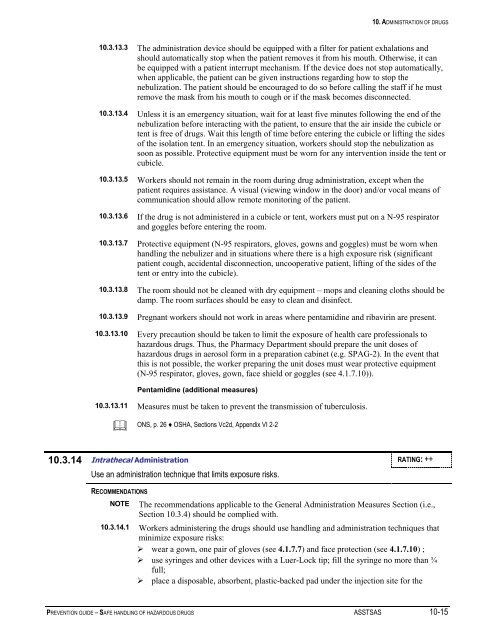Prevention Guide - Safe Handling of Hazardous Drugs - Irsst
Prevention Guide - Safe Handling of Hazardous Drugs - Irsst
Prevention Guide - Safe Handling of Hazardous Drugs - Irsst
You also want an ePaper? Increase the reach of your titles
YUMPU automatically turns print PDFs into web optimized ePapers that Google loves.
10. ADMINISTRATION OF DRUGS<br />
10.3.13.3 The administration device should be equipped with a filter for patient exhalations and<br />
should automatically stop when the patient removes it from his mouth. Otherwise, it can<br />
be equipped with a patient interrupt mechanism. If the device does not stop automatically,<br />
when applicable, the patient can be given instructions regarding how to stop the<br />
nebulization. The patient should be encouraged to do so before calling the staff if he must<br />
remove the mask from his mouth to cough or if the mask becomes disconnected.<br />
10.3.13.4 Unless it is an emergency situation, wait for at least five minutes following the end <strong>of</strong> the<br />
nebulization before interacting with the patient, to ensure that the air inside the cubicle or<br />
tent is free <strong>of</strong> drugs. Wait this length <strong>of</strong> time before entering the cubicle or lifting the sides<br />
<strong>of</strong> the isolation tent. In an emergency situation, workers should stop the nebulization as<br />
soon as possible. Protective equipment must be worn for any intervention inside the tent or<br />
cubicle.<br />
10.3.13.5 Workers should not remain in the room during drug administration, except when the<br />
patient requires assistance. A visual (viewing window in the door) and/or vocal means <strong>of</strong><br />
communication should allow remote monitoring <strong>of</strong> the patient.<br />
10.3.13.6 If the drug is not administered in a cubicle or tent, workers must put on a N-95 respirator<br />
and goggles before entering the room.<br />
10.3.13.7 Protective equipment (N-95 respirators, gloves, gowns and goggles) must be worn when<br />
handling the nebulizer and in situations where there is a high exposure risk (significant<br />
patient cough, accidental disconnection, uncooperative patient, lifting <strong>of</strong> the sides <strong>of</strong> the<br />
tent or entry into the cubicle).<br />
10.3.13.8 The room should not be cleaned with dry equipment – mops and cleaning cloths should be<br />
damp. The room surfaces should be easy to clean and disinfect.<br />
10.3.13.9 Pregnant workers should not work in areas where pentamidine and ribavirin are present.<br />
10.3.13.10 Every precaution should be taken to limit the exposure <strong>of</strong> health care pr<strong>of</strong>essionals to<br />
hazardous drugs. Thus, the Pharmacy Department should prepare the unit doses <strong>of</strong><br />
hazardous drugs in aerosol form in a preparation cabinet (e.g. SPAG-2). In the event that<br />
this is not possible, the worker preparing the unit doses must wear protective equipment<br />
(N-95 respirator, gloves, gown, face shield or goggles (see 4.1.7.10)).<br />
Pentamidine (additional measures)<br />
10.3.13.11 Measures must be taken to prevent the transmission <strong>of</strong> tuberculosis.<br />
<br />
ONS, p. 26 ♦ OSHA, Sections Vc2d, Appendix VI 2-2<br />
10.3.14 Intrathecal Administration RATING: ++<br />
Use an administration technique that limits exposure risks.<br />
RECOMMENDATIONS<br />
NOTE<br />
The recommendations applicable to the General Administration Measures Section (i.e.,<br />
Section 10.3.4) should be complied with.<br />
10.3.14.1 Workers administering the drugs should use handling and administration techniques that<br />
minimize exposure risks:<br />
‣ wear a gown, one pair <strong>of</strong> gloves (see 4.1.7.7) and face protection (see 4.1.7.10) ;<br />
‣ use syringes and other devices with a Luer-Lock tip; fill the syringe no more than ¾<br />
full;<br />
‣ place a disposable, absorbent, plastic-backed pad under the injection site for the<br />
PREVENTION GUIDE – SAFE HANDLING OF HAZARDOUS DRUGS ASSTSAS 10-15

















